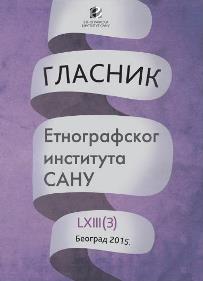Mobilnost na Balkanu: privremenost, vrste, trendovi
DOI: 10.2298/GEI1503515K; UDC: 314.7(497)
Сажетак
Cilj ovog članka je da pažljivo analizira fenomen balkanskih migracija, i da istakne povezanost između kontinuiteta i diskontinuiteta u obrazloženju migracija, izraženu u trendovima, kao i u prodorima i promenama. Četiri perioda su izražena kroz glavne trendove. Tipologija balkanskih migracija identifikuje deset vrsta , razvrstanih u
tri veće kategorije. Članak razlikuje i upoređuje modele nacionalne migracije i crta panoramski sliku glavnih trendova u poslednjoj četvrtini veka.
Ključne reči: Jugoistočna Evropa, prisilna migracija, etnički migracije, migracija radne snage, povratak.
Reference
Hristov P. (2012). Gurbet i identičnost (po materiali ot Zapadna Bulgarija, Istočna Srbjia i Zapadna Makedonjia). Sociologičeski problemi, 1-2, 186-202.
Baldwin-Edwards M. (2005) Balkan migrations and the European Union: patterns and trends.- Romanian Journal of European Studies, N 4, 31 – 44.
Barbulescu R. (2009) The economic crisis and its effects for intra-european movement: mobility patterns and sate responses. The case of Romanians in Spain. Paper at the Annual Conference 2009 of the Centre on migration, policy and society, University of Oxford “New times? Economic crisis, geopolitical transformation and the emergent migration order”
Bobic M. (2010) Serbian unfinished business. Refugees and IDPS.- In: Krasteva A., A. Kasabova, D. Karabonova (eds) (2010) Migrations from and to Southeastern Europe. Ravenna: Longo Editore, 211 – 224.
Bonifazi C. and M. Mamolo (2004) Past and current trends of Balkan migrations.- Espaces, populations, societies, N 3, 519 – 531.
Borjas G. J. (1989) Economic theory and international migration.-International Migration Review, N 3, 457 – 485.
Bozic S. (2007) Croatia.- In: Migration flows in Southeast Europe, a compendium of national perspectives. Belgrade: Group 484, 11 – 42.
Carletto G., Davis B, Stampini M. and Zezza A. (2006) A country on the move: international migrations in post-communist Albania.- International Migration Review 40 (4), 767 – 85.
Comini D. and F. Faes-Cannito (2009) Remittances from the EU down for the first time in 2009, flows to non-EU countries more resilient.-Eurstat, 2010, N 40.
Diminescu D. (2004) Visibles, mais peu nombreux. Les circulations migratoires roumaines. Paris : MSH.
Dobre S. and V. Ariton (2008) Romania. Migration and development: creating regional labor markets and labor market circulation as response to regional market demands. Paper for Group 484.
GALLUP (2009) The impact of migration.- Balkan Monitor. Insights and perceptions: voices of the Balkans. June 2009, 1-9.
King R. (2005) Albania as a labotary for the study of migration and development.-Journal of South Europe and the Balkans, 7(2), 13 – 56.
Krasteva A. (2007) Post-communist discovery of immigration: the case of Bulgaria.- In: Berggren E. et al (eds) Irregular migration, informal labor and community: a challenge for Europe. Maastricht: Shaker Publishing, 104 – 117.
Krasteva A. (2007a) Bulgaria.- In: Migration flows in Southeast Europe, a compendium of national perspectives. Belgrade: Group 484, 163 – 193.
Krasteva A. et al (2007 b) Human traffickingking: the Bulgarian case. Paper for HERA international project.
Krasteva A. (2008) L’immigration en Bulgarie : culture d’entreprise et questions d’intégration.- Hommes et migrations, N 1275, 112 – 126.
Krasteva A., A.Kasabova, D. Karabonova (eds) (2010) Migrations from and to Southeastern Europe. Ravenna: Longo Editore.
Krasteva A.(2010) Introduction.-In: Krasteva A., A.Kasabova, D. Karabonova (eds) Migrations from and to Southeastern Europe. Ravenna: Longo Editore, 2010, 9 – 14.
Lazariou S. (2007) Romania.- In: Migration flows in Southeast Europe, a compendium of national perspectives. Belgrade: Group 484, 109 – 161.
Laczko F., A. von Koppenfels and J. Barthel. (2002) Traffickingking in women from Central and Eastern Europe: a review of statistical data.- In: Laczko F., I. Stacher and Koppenfels A. von (eds) New challenges for migration policy in Central and Eastern Europe. The Hague: IOM: TMC Asser press, 153 – 174.
Marinkovic D. (2007) Bosnia and Herzegovina.- In: Migration flows in Southeast Europe, a compendium of national perspectives. Belgrade: Group 484, 43 – 75.
Mesic M. and D. Bagic (2010) Serb returnees in Croatia – the question of return sustainability.-International migration, vol. 48 (2), 133 – 160.
Morokvasic M. (2003). Transntional mobility and gender& a vew from post-war Europe. In M. Morokvasic, U. Erel, & K. Shinozaki (Eds.), Crossing borders and shifting boundaries: gender on the move. Opladen: Leske+Burich.
OECD (2010) International migration outlook. www.oecd.org/els/migration/imo
Papademetriou D. and A. Terrazas (2009) Immigrants and the current economic crisis: research evidence, policy challenges and implications. http://www.migrationpolicy.org/pubs/lmi_recessionJan09.pdf
Pons-Vignon N. (2010) Don’t waste the crisis: critical perspective for a new economic model. Geneva :ILO. http://www.ilo.org/wcmsp5/groups/public/---dgreports/---dcomm/---publ/documents/genericdocument/wcms_141464.pdf
Van Hear N. (1998) New Diasporas. London: UCL Press.
Vasileva K. (2009) Population and social conditions.- Eurostat, N 94, 1-7.
Vulnetari J. (2007) Albanian migration and development: state of the art review. IMISCO working paper. September 2007.
<https://www.ei.sanu.ac.rs/index.php/gei/article/view/230>.
Датум приступа: 23 nov. 2025






